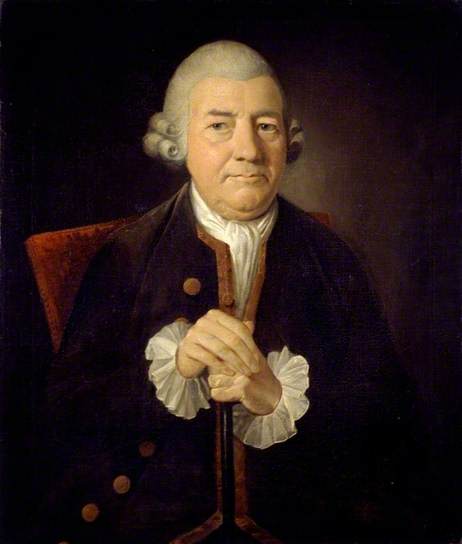“Printing ink is made of nut-oil”
In his Cyclopaedia, or An Universal Dictionary of Arts and Sciences, published in many editions in the early 1700s, Ephraim Chambers wrote: “Printing ink is made of nut-oil, or linseed-oil, turpentine, and lamp-black.”
The manufacturing process was complex, and no doubt part of the art and mystery of being a printer. One leading figure in that profession in London was John Baskerville (1707–1775, shown here).
Fifty years after Baskerville’s death, T. C. Hansard (1776–1833) published in Typographia what he understood to be the man’s method of making ink:
The “most serious consequences” Hansard warned about meant fires. He advised printers not to boil linseed oil inside their shops, and also to be prepared to smother any oil fire by “instantly closing the pot or vessel, so that no air can draw in to feed the flame.”
The boiled linseed oil turned into a type of varnish. That base made printing ink very sticky, so it adhered to the printing type and then to paper without flowing or smearing.
The manufacturing process was complex, and no doubt part of the art and mystery of being a printer. One leading figure in that profession in London was John Baskerville (1707–1775, shown here).
Fifty years after Baskerville’s death, T. C. Hansard (1776–1833) published in Typographia what he understood to be the man’s method of making ink:
He took of the finest and oldest linseed oil three gallons, this was put into a vessel capable of holding four times the quantity, and boiled with a long-continued fire till it acquired a certain thickness or tenacity, according to the quality of the work it was intended to print, and which was judged of by putting small quantities upon a stone to cool, and then taking it up between the finger and thumb; on opening which, if it drew into a thread an inch long or more, it was considered sufficiently boiled. This mode of boiling can only be acquired by long practice, and requires particular skill and care in the person who superintends the operation, as, for want of this, the most serious consequences may occur, and have very frequently occurred.The “fine black” was soot collected from “glass-pinchers’ and solderers’ lamps,” according to William Savage’s On the Preparation of Printing Ink (1832). For red ink, printers used vermilion, a mercury compound.
The oil thus prepared was suffered to cool, and then a small quantity of black or amber rosin was dissolved in it, after which it was allowed some months to subside; it was then mixed with the fine black…to a proper thickness, and ground for use.
The “most serious consequences” Hansard warned about meant fires. He advised printers not to boil linseed oil inside their shops, and also to be prepared to smother any oil fire by “instantly closing the pot or vessel, so that no air can draw in to feed the flame.”
The boiled linseed oil turned into a type of varnish. That base made printing ink very sticky, so it adhered to the printing type and then to paper without flowing or smearing.


No comments:
Post a Comment